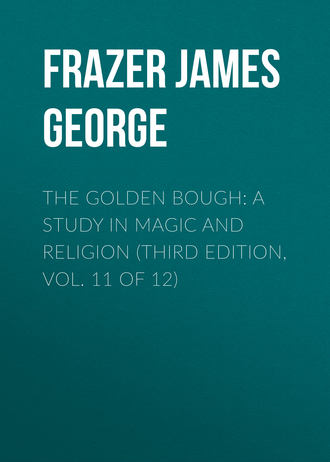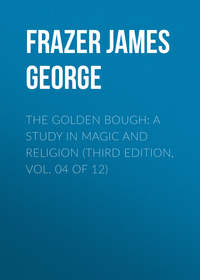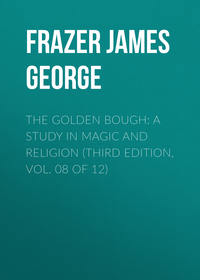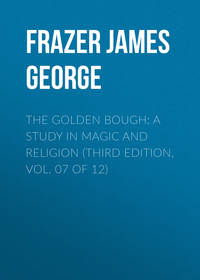 полная версия
полная версияThe Golden Bough: A Study in Magic and Religion (Third Edition, Vol. 11 of 12)
The men, women, and animals burnt at these festivals were perhaps thought to be witches or wizards in disguise.
We have still to ask, What is the meaning of such sacrifices? Why were men and animals burnt to death at these festivals? If we are right in interpreting the modern European fire-festivals as attempts to break the power of witchcraft by burning or banning the witches and warlocks, it seems to follow that we must explain the human sacrifices of the Celts in the same manner; that is, we must suppose that the men whom the Druids burnt in wicker-work images were condemned to death on the ground that they were witches or wizards, and that the mode of execution by fire was chosen because, as we have seen, burning alive is deemed the surest mode of getting rid of these noxious and dangerous beings. The same explanation would apply to the cattle and wild animals of many kinds which the Celts burned along with the men.107 They, too, we may conjecture, were supposed to be either under the spell of witchcraft or actually to be the witches and wizards, who had transformed themselves into animals for the purpose of prosecuting their infernal plots against the welfare of their fellow creatures. This conjecture is confirmed by the observation that the victims most commonly burned in modern bonfires have been cats, and that cats are precisely the animals into which, with the possible exception of hares, witches were most usually supposed to transform themselves. Again, we have seen that serpents and foxes used sometimes to be burnt in the midsummer fires;108 and Welsh and German witches are reported to have assumed the form both of foxes and serpents.109 In short, when we remember the great variety of animals whose forms witches can assume at pleasure,110 it seems easy on this hypothesis to account for the variety of living creatures that have been burnt at festivals both in ancient Gaul and modern Europe; all these victims, we may surmise, were doomed to the flames, not because they were animals, but because they were believed to be witches who had taken the shape of animals for their nefarious purposes. One advantage of explaining the ancient Celtic sacrifices in this way is that it introduces, as it were, a harmony and consistency into the treatment which Europe has meted out to witches from the earliest times down to about two centuries ago, when the growing influence of rationalism discredited the belief in witchcraft and put a stop to the custom of burning witches. On this view the Christian Church in its dealings with the black art merely carried out the traditional policy of Druidism, and it might be a nice question to decide which of the two, in pursuance of that policy, exterminated the larger number of innocent men and women.111 Be that as it may, we can now perhaps understand why the Druids believed that the more persons they sentenced to death, the greater would be the fertility of the land.112 To a modern reader the connexion at first sight may not be obvious between the activity of the hangman and the productivity of the earth. But a little reflection may satisfy him that when the criminals who perish at the stake or on the gallows are witches, whose delight it is to blight the crops of the farmer or to lay them low under storms of hail, the execution of these wretches is really calculated to ensure an abundant harvest by removing one of the principal causes which paralyze the efforts and blast the hopes of the husbandman.
Mannhardt thought that the men and animals whom the Druids burned in wickerwork images represented spirits of vegetation, and that the burning of them was a charm to secure a supply of sunshine for the crops.
The Druidical sacrifices which we are considering were explained in a different way by W. Mannhardt. He supposed that the men whom the Druids burned in wickerwork images represented the spirits of vegetation, and accordingly that the custom of burning them was a magical ceremony intended to secure the necessary sunshine for the crops. Similarly, he seems to have inclined to the view that the animals which used to be burnt in the bonfires represented the corn-spirit,113 which, as we saw in an earlier part of this work, is often supposed to assume the shape of an animal.114 This theory is no doubt tenable, and the great authority of W. Mannhardt entitles it to careful consideration. I adopted it in former editions of this book; but on reconsideration it seems to me on the whole to be less probable than the theory that the men and animals burnt in the fires perished in the character of witches. This latter view is strongly supported by the testimony of the people who celebrate the fire-festivals, since a popular name for the custom of kindling the fires is “burning the witches,” effigies of witches are sometimes consumed in the flames, and the fires, their embers, or their ashes are supposed to furnish protection against witchcraft. On the other hand there is little to shew that the effigies or the animals burnt in the fires are regarded by the people as representatives of the vegetation-spirit, and that the bonfires are sun-charms. With regard to serpents in particular, which used to be burnt in the midsummer fire at Luchon, I am not aware of any certain evidence that in Europe snakes have been regarded as embodiments of the tree-spirit or corn-spirit,115 though in other parts of the world the conception appears to be not unknown.116 Whereas the popular faith in the transformation of witches into animals is so general and deeply rooted, and the fear of these uncanny beings is so strong, that it seems safer to suppose that the cats and other animals which were burnt in the fire suffered death as embodiments of witches than that they perished as representatives of vegetation-spirits.
Chapter VIII. The Magic Flowers of Midsummer Eve
It is a common belief in Europe that plants acquire certain magical, but transient, virtues on Midsummer Eve. Magical plants culled on Midsummer Eve (St. John's Eve) or Midsummer Day (St. John's Day) in France. St. John's herb.
A feature of the great midsummer festival remains to be considered, which may perhaps help to clear up the doubt as to the meaning of the fire-ceremonies and their relation to Druidism. For in France and England, the countries where the sway of the Druids is known to have been most firmly established, Midsummer Eve is still the time for culling certain magic plants, whose evanescent virtue can be secured at this mystic season alone. Indeed all over Europe antique fancies of the same sort have lingered about Midsummer Eve, imparting to it a fragrance of the past, like withered rose leaves that, found by chance in the pages of an old volume, still smell of departed summers. Thus in Saintonge and Aunis, two of the ancient provinces of Western France, we read that “of all the festivals for which the merry bells ring out there is not one which has given rise to a greater number of superstitious practices than the festival of St. John the Baptist. The Eve of St. John was the day of all days for gathering the wonderful herbs by means of which you could combat fever, cure a host of diseases, and guard yourself against sorcerers and their spells. But in order to attain these results two conditions had to be observed; first, you must be fasting when you gathered the herbs, and second, you must cull them before the sun rose. If these conditions were not fulfilled, the plants had no special virtue.”117 In the neighbouring province of Perigord the person who gathered the magic herbs before sunrise at this season had to walk backwards, to mutter some mystic words, and to perform certain ceremonies. The plants thus collected were carefully kept as an infallible cure for fever; placed above beds and the doors of houses and of cattle-sheds they protected man and beast from disease, witchcraft, and accident.118 In Normandy a belief in the marvellous properties of herbs and plants, of flowers and seeds and leaves gathered, with certain traditional rites, on the Eve or the Day of St. John has remained part of the peasant's creed to this day. Thus he fancies that seeds of vegetables and plants, which have been collected on St. John's Eve, will keep better than others, and that flowers plucked that day will never fade.119 Indeed so widespread in France used to be the faith in the magic virtue of herbs culled on that day that there is a French proverb “to employ all the herbs of St. John in an affair,” meaning “to leave no stone unturned.”120 In the early years of the nineteenth century a traveller reported that at Marseilles, “on the Eve of St. John, the Place de Noailles and the course are cleaned. From three o'clock in the morning the country-people flock thither, and by six o'clock the whole place is covered with a considerable quantity of flowers and herbs, aromatic or otherwise. The folk attribute superstitious virtues to these plants; they are persuaded that if they have been gathered the same day before sunrise they are fitted to heal many ailments. People buy them emulously to give away in presents and to fill the house with.”121 On the Eve of St. John (Midsummer Eve), before sunset, the peasants of Perche still gather the herb called St. John's herb. It is a creeping plant, very aromatic, with small flowers of a violet blue. Other scented flowers are added, and out of the posies they make floral crosses and crowns, which they hang up over the doors of houses and stables. Such floral decorations are sold like the box-wood on Palm Sunday, and the withered wreaths are kept from year to year. If an animal dies, it may be a cow, they carefully clean the byre or the stable, make a pile of these faded garlands, and set them on fire, having previously closed up all the openings and interstices, so that the whole place is thoroughly fumigated. This is thought to eradicate the germs of disease from the byre or stable.122 At Nellingen, near Saaralben, in Lorraine the hedge doctors collect their store of simples between eleven o'clock and noon on Midsummer Day; and on that day nut-water is brewed from nuts that have been picked on the stroke of noon. Such water is a panacea for all ailments.123 In the Vosges Mountains they say that wizards have but one day in the year, and but one hour in that day, to find and cull the baleful herbs which they use in their black art. That day is the Eve of St. John, and that hour is the time when the church bells are ringing the noonday Angelus. Hence in many villages they say that the bells ought not to ring at noon on that day.124
Magical plants culled on Midsummer Eve or Midsummer Day in the Tyrol and Germany.
In the Tyrol also they think that the witching hour is when the Ave Maria bell is ringing on Midsummer Eve, for then the witches go forth to gather the noxious plants whereby they raise thunderstorms. Therefore in many districts the bells ring for a shorter time than usual that evening;125 at Folgareit the sexton used to steal quietly into the church, and when the clock struck three he contented himself with giving a few pulls to the smallest of the bells.126 At Rengen, in the Eifel Mountains, the sexton rings the church bell for an hour on the afternoon of Midsummer Day. As soon as the bell begins to ring, the children run out into the meadows, gather flowers, and weave them into garlands which they throw on the roofs of the houses and buildings. There the garlands remain till the wind blows them away. It is believed that they protect the houses against fire and thunderstorms.127 At Niederehe, in the Eifel Mountains, on Midsummer Day little children used to make wreaths and posies out of “St. John's flowers and Maiden-flax” and throw them on the roofs. Some time afterwards, when the wild gooseberries were ripe, all the children would gather round an old woman on a Sunday afternoon, and taking the now withered wreaths and posies with them march out of the village, praying while they walked. Wreaths and posies were then thrown in a heap and kindled, whereupon the children snatched them up, still burning, and ran and fumigated the wild gooseberry bushes with the smoke. Then they returned with the old woman to the village, knelt down before her, and received her blessing. From that time the children were free to pick and eat the wild gooseberries.128 In the Mark of Brandenburg the peasants gather all sorts of simples on Midsummer Day, because they are of opinion that the drugs produce their medicinal effect only if they have been culled at that time. Many of these plants, especially roots, must be dug up at midnight and in silence.129 In Mecklenburg not merely is a special healing virtue ascribed to simples collected on Midsummer Day; the very smoke of such plants, if they are burned in the fire, is believed to protect a house against thunder and lightning, and to still the raging of the storm.130 The Wends of the Spreewald twine wreaths of herbs and flowers at midsummer, and hang them up in their rooms; and when any one gets a fright he will lay some of the leaves and blossoms on hot coals and fumigate himself with the smoke.131 In Eastern Prussia, some two hundred years ago, it used to be customary on Midsummer Day to make up a bunch of herbs of various sorts and fasten it to a pole, which was then put up over the gate or door through which the corn would be brought in at harvest. Such a pole was called Kaupole, and it remained in its place till the crops had been reaped and garnered. Then the bunch of herbs was taken down; part of it was put with the corn in the barn to keep rats and mice from the grain, and part was kept as a remedy for diseases of all sorts.132
Magical plants culled on Midsummer Eve (St. John's Eve) or Midsummer Day in Austria and Russia.
The Germans of West Bohemia collect simples on St. John's Night, because they believe the healing virtue of the plants to be especially powerful at that time.133 The theory and practice of the Huzuls in the Carpathian Mountains are similar; they imagine that the plants gathered on that night are not only medicinal but possess the power of restraining the witches; some say that the herbs should be plucked in twelve gardens or meadows.134 Among the simples which the Czechs and Moravians of Silesia cull at this season are dandelions, ribwort, and the bloom of the lime-tree.135 The Esthonians of the island of Oesel gather St. John's herbs (Jani rohhud) on St. John's Day, tie them up in bunches, and hang them up about the houses to prevent evil spirits from entering. A subsidiary use of the plants is to cure diseases; gathered at that time they have a greater medical value than if they were collected at any other season. Everybody does not choose exactly the same sorts of plants; some gather more and some less, but in the collection St. John's wort (Jani rohhi, Hypericum perforatum) should never be wanting.136 A writer of the early part of the seventeenth century informs us that the Livonians, among whom he lived, were impressed with a belief in the great and marvellous properties possessed by simples which had been culled on Midsummer Day. Such simples, they thought, were sure remedies for fever and for sickness and pestilence in man and beast; but if gathered one day too late they lost all their virtue.137 Among the Letts of the Baltic provinces of Russia girls and women go about on Midsummer Day crowned with wreaths of aromatic plants, which are afterwards hung up for good luck in the houses. The plants are also dried and given to cows to eat, because they are supposed to help the animals to calve.138
Magical plants culled on St. John's Eve or St. John's Day among the South Slavs, in Macedonia, and Bolivia.
In Bulgaria St. John's Day is the special season for culling simples. On this day, too, Bulgarian girls gather nosegays of a certain white flower, throw them into a vessel of water, and place the vessel under a rose-tree in bloom. Here it remains all night. Next morning they set it in the courtyard and dance singing round it. An old woman then takes the flowers out of the vessel, and the girls wash themselves with the water, praying that God would grant them health throughout the year. After that the old woman restores her nosegay to each girl and promises her a rich husband.139 Among the South Slavs generally on St. John's Eve it is the custom for girls to gather white flowers in the meadows and to place them in a sieve or behind the rafters. A flower is assigned to each member of the household: next morning the flowers are inspected; and he or she whose flower is fresh will be well the whole year, but he or she whose flower is faded will be sickly or die. Garlands are then woven out of the flowers and laid on roofs, folds, and beehives.140 In some parts of Macedonia on St. John's Eve the peasants are wont to festoon their cottages and gird their own waists with wreaths of what they call St. John's flower; it is the blossom of a creeping plant which resembles honeysuckle.141 Similar notions as to the magical virtue which plants acquire at midsummer have been transported by Europeans to the New World. At La Paz in Bolivia people believe that flowers of mint (Yerba buena) gathered before sunrise on St. John's Day foretell an endless felicity to such as are so lucky as to find them.142
Magical plants culled at Midsummer among the Mohammedans of Morocco.
Nor is the superstition confined to Europe and to people of European descent. In Morocco also the Mohammedans are of opinion that certain plants, such as penny-royal, marjoram, and the oleander, acquire a special magic virtue (baraka) when they are gathered shortly before midsummer. Hence the people collect these plants at this season and preserve them for magical or medical purposes. For example, branches of oleander are brought into the houses before midsummer and kept under the roof as a charm against the evil eye; but while the branches are being brought in they may not touch the ground, else they would lose their marvellous properties. Cases of sickness caused by the evil eye are cured by fumigating the patients with the smoke of these boughs. The greatest efficacy is ascribed to “the sultan of the oleander,” which is a stalk with four pairs of leaves clustered round it. Such a stalk is always endowed with magical virtue, but that virtue is greatest when the stalk has been cut just before midsummer. Arab women in the Hiaina district of Morocco gather Daphne gnidium on Midsummer Day, dry it in the sun, and make it into a powder which, mixed with water, they daub on the heads of their little children to protect them from sunstroke and vermin and to make their hair grow well. Indeed such marvellous powers do these Arabs attribute to plants at this mystic season that a barren woman will walk naked about a vegetable garden on Midsummer Night in the hope of conceiving a child through the fertilizing influence of the vegetables.143
Seven different sorts of magical plants gathered at Midsummer. Nine different sorts of plants gathered at Midsummer. Dreams of love on flowers at Midsummer Eve. Love's watery mirror at Midsummer Eve.
Sometimes in order to produce the desired effect it is deemed necessary that seven or nine different sorts of plants should be gathered at this mystic season. Norman peasants, who wish to fortify themselves for the toil of harvest, will sometimes go out at dawn on St. John's Day and pull seven kinds of plants, which they afterwards eat in their soup as a means of imparting strength and suppleness to their limbs in the harvest field.144 In Mecklenburg maidens are wont to gather seven sorts of flowers at noon on Midsummer Eve. These they weave into garlands, and sleep with them under their pillows. Then they are sure to dream of the men who will marry them.145 But the flowers on which youthful lovers dream at Midsummer Eve are oftener nine in number. Thus in Voigtland nine different kinds of flowers are twined into a garland at the hour of noon, but they may not enter the dwelling by the door in the usual way; they must be passed through the window, or, if they come in at the door, they must be thrown, not carried, into the house. Sleeping on them that night you will dream of your future wife or future husband.146 The Bohemian maid, who gathers nine kinds of flowers on which to dream of love at Midsummer Eve, takes care to wrap her hand in a white cloth, and afterwards to wash it in dew; and when she brings her garland home she must speak no word to any soul she meets by the way, for then all the magic virtue of the flowers would be gone.147 Other Bohemian girls look into the book of fate at this season after a different fashion. They twine their hair with wreaths made of nine sorts of leaves, and go, when the stars of the summer night are twinkling in the sky, to a brook that flows beside a tree. There, gazing on the stream, the girl beholds, beside the broken reflections of the tree and the stars, the watery image of her future lord.148 So in Masuren maidens gather nosegays of wild flowers in silence on Midsummer Eve. At the midnight hour each girl takes the nosegay and a glass of water, and when she has spoken certain words she sees her lover mirrored in the water.149
Garlands of flowers of nine sorts gathered at Midsummer and used in divination and medicine.
Sometimes Bohemian damsels make a different use of their midsummer garlands twined of nine sorts of flowers. They lie down with the garland laid as a pillow under their right ear, and a hollow voice, swooning from underground, proclaims their destiny.150 Yet another mode of consulting the oracle by means of these same garlands is to throw them backwards and in silence upon a tree at the hour of noon, just when the flowers have been gathered. For every time that the wreath is thrown without sticking to the branches of the tree the girl will have a year to wait before she weds. This mode of divination is practised in Voigtland,151 East Prussia,152 Silesia,153 Belgium,154 and Wales,155 and the same thing is done in Masuren, although we are not told that there the wreaths must be composed of nine sorts of flowers.156 However, in Masuren chaplets of nine kinds of herbs are gathered on St. John's Eve and put to a more prosaic use than that of presaging the course of true love. They are carefully preserved, and the people brew a sort of tea from them, which they administer as a remedy for many ailments; or they keep the chaplets under their pillows till they are dry, and thereupon dose their sick cattle with them.157 In Esthonia the virtues popularly ascribed to wreaths of this sort are many and various. These wreaths, composed of nine kinds of herbs culled on the Eve or the Day of St. John, are sometimes inserted in the roof or hung up on the walls of the house, and each of them receives the name of one of the inmates. If the plants which have been thus dedicated to a girl happen to take root and grow in the chinks and crannies, she will soon wed; if they have been dedicated to an older person and wither away, that person will die. The people also give them as medicine to cattle at the time when the animals are driven forth to pasture; or they fumigate the beasts with the smoke of the herbs, which are burnt along with shavings from the wooden threshold. Bunches of the plants are also hung about the house to keep off evil spirits, and maidens lay them under their pillows to dream on.158 In Sweden the “Midsummer Brooms,” made up of nine sorts of flowers gathered on Midsummer Eve, are put to nearly the same uses. Fathers of families hang up such “brooms” to the rafters, one for each inmate of the house; and he or she whose broom (quast) is the first to wither will be the first to die. Girls also dream of their future husbands with these bunches of flowers under their pillows. A decoction made from the flowers is, moreover, a panacea for all disorders, and if a bunch of them be hung up in the cattle shed, the Troll cannot enter to bewitch the beasts.159 The Germans of Moravia think that nine kinds of herbs gathered on St. John's Night (Midsummer Eve) are a remedy for fever;160 and some of the Wends attribute a curative virtue in general to such plants.161
St. John's wort (Hypericum perforatum) gathered for magical purposes at Midsummer. St. John's blood on St. John's Day.
Of the flowers which it has been customary to gather for purposes of magic or divination at midsummer none perhaps is so widely popular as St. John's wort (Hypericum perforatum). The reason for associating this particular plant with the great summer festival is perhaps not far to seek, for the flower blooms about Midsummer Day, and with its bright yellow petals and masses of golden stamens it might well pass for a tiny copy on earth of the great sun which reaches its culminating point in heaven at this season. Gathered on Midsummer Eve, or on Midsummer Day before sunrise, the blossoms are hung on doorways and windows to preserve the house against thunder, witches, and evil spirits; and various healing properties are attributed to the different species of the plant. In the Tyrol they say that if you put St. John's wort in your shoe before sunrise on Midsummer Day you may walk as far as you please without growing weary. In Scotland people carried it about their persons as an amulet against witchcraft. On the lower Rhine children twine chaplets of St. John's wort on the morning of Midsummer Day, and throw them on the roofs of the houses. Here, too, the people who danced round the midsummer bonfires used to wear wreaths of these yellow flowers in their hair, and to deck the images of the saints at wayside shrines with the blossoms. Sometimes they flung the flowers into the bonfires. In Sicily they dip St. John's wort in oil, and so apply it as a balm for every wound. During the Middle Ages the power which the plant notoriously possesses of banning devils won for it the name of fuga daemonum; and before witches and wizards were stretched on the rack or otherwise tortured, the flower used to be administered to them as a means of wringing the truth from their lips.162 In North Wales people used to fix sprigs of St. John's wort over their doors, and sometimes over their windows, “in order to purify their houses, and by that means drive away all fiends and evil spirits.”163 In Saintonge and Aunis the flowers served to detect the presence of sorcerers, for if one of these pestilent fellows entered a house, the bunches of St. John's wort, which had been gathered on Midsummer Eve and hung on the walls, immediately dropped their yellow heads as if they had suddenly faded.164 However, the Germans of Western Bohemia think that witches, far from dreading St. John's wort, actually seek the plant on St. John's Eve.165 Further, the edges of the calyx and petals of St. John's wort, as well as their external surface, are marked with dark purple spots and lines, which, if squeezed, yield a red essential oil soluble in spirits.166 German peasants believe that this red oil is the blood of St. John,167 and this may be why the plant is supposed to heal all sorts of wounds.168 In Mecklenburg they say that if you pull up St. John's wort at noon on Midsummer Day you will find at the root a bead of red juice called St. John's blood; smear this blood on your shirt just over your heart, and no mad dog will bite you.169 In the Mark of Brandenburg the same blood, procured in the same manner and rubbed on the barrel of a gun, will make every shot from that gun to hit the mark.170 According to others, St. John's blood is found at noon on St. John's Day, and only then, adhering in the form of beads to the root of a weed called knawel, which grows in sandy soil. But some people say that these beads of red juice are not really the blood of the martyred saint, but only insects resembling the cochineal or kermes-berry.171 “About Hanover I have often observed devout Roman Catholics going on the morning of St. John's day to neighbouring sandhills, gathering on the roots of herbs a certain insect (Coccus Polonica) looking like drops of blood, and thought by them to be created on purpose to keep alive the remembrance of the foul murder of St. John the Baptist, and only to be met with on the morning of the day set apart for him by the Church. I believe the life of this insect is very ephemeral, but by no means restricted to the twenty-fourth of June.”172








